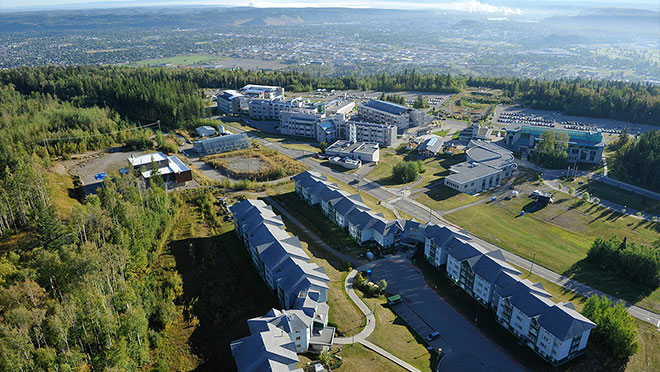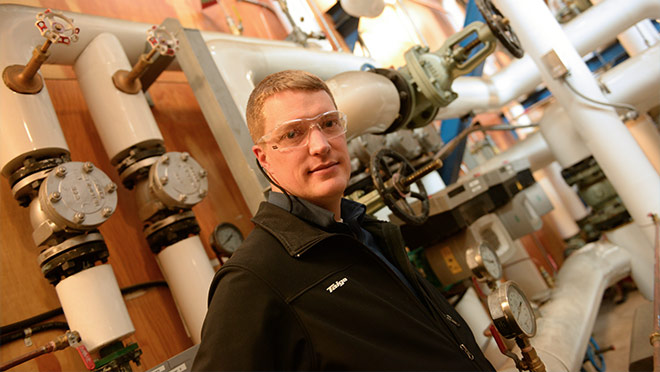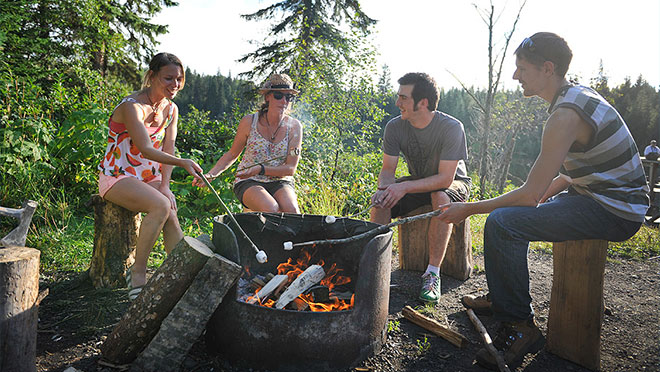Energy savings and green cred help put UNBC on the map

Atop a hill in Prince George, 'Canada's Green University' carves out a winning identity
David Claus followed his parents from Vancouver Island to Prince George and eventually helped deliver on energy savings of $5 million-plus at a university that most people in Canada had never heard of.
Danika Doucette crossed the country to study environmental engineering, fell in love with the small class sizes at the University of Northern BC and the wealth of recreational opportunities outside her door. Ten years later, she works as an engineer-in-training as UNBC's energy manager, a position she didn't know existed when she arrived in B.C.
Cameron Bell was drawn to UNBC's environmental studies program as a way to be close to B.C.'s mountains. After graduating he stayed in B.C., and is now running a fledgling vegetable farm while also teaching skiing in Terrace.
UNBC may have first been built to give students in north and central B.C. an option to study closer to home. But its decision in 2007 to go big on sustainability and trumpet itself as Canada's Green University has added muscle to its mandate and extended its reach. For 10 straight years, it has been ranked by MacLean's magazine in the top three of the country's best small universities.
A stunning university featuring attractive slate, stone and wood buildings and sunlit atriums sitting atop a hill overlooking Prince George, UNBC is no longer a secret.
Sustainable energy management key to green cred
At the heart of UNBC's sustainability mandate is the school's strategic energy management work, supported by BC Hydro. The utility provides support for a dedicated energy manager, incentives for energy efficiency projects, and access to a network of energy specialists and consultants.
UNBC's energy management program has implemented projects that have saved over $2 million in utility costs. When savings from the university's bioenergy and wood pellet plants are factored in, UNBC has saved more than $5 million on utilities.
In working with BC Hydro to save money and, in turn, build a green brand, UNBC is far from alone. Whistler-Blackcomb's work with BC Hydro has helped the ski resort save nearly 14 million kWh of electricity in 10 years, the equivalent of powering 1,400 B.C. homes per year. The resort, which uses less electricity in 2018 than it did in 2005 and which diverts 72% of its waste from landfills, is now used as the sustainability model for its parent company Vail Resorts and its 37 ski operations in North America.
A six-hour drive south of Prince George, Thompson Rivers University at Kamloops is one of only five universities in North America with a platinum rating in STARS, the world's go-to sustainability barometer for higher learning. TRU has seen a 32% reduction in energy consumption even as the campus has added the equivalent of twenty 10,000-square-foot buildings to the campus, with its lighting upgrades alone saving more than $100,000 a year in electricity costs.
Many B.C. universities and businesses have discovered that investment in energy savings doesn't just save millions of dollars. It also helps deliver on the public's growing expectations around sustainability.
A 2019 study commissioned for BC Hydro shows that sustainability is important to four out of five British Columbians, that 56% say they'd pay more for sustainable products, and that 76% said they'd be proud if their employer was a recognized leader in sustainability.
In a nutshell, green branding pays off. And it works best when it pays for itself.

UNBC uses revolving loan to fund new projects
Energy managers across B.C. use a variety of methods to help maintain existing projects and add more to the mix. Burnaby School District, for example, uses rebates from completed projects to help fund future projects. UNBC, on the other hand, puts a portion of energy cost savings from completed projects into a revolving loan.
As UNBC's first energy manager, Claus first put metering in place at the campus so that he could provide detailed energy use data and quantify how projects might deliver on savings. Then came the challenge of trying to fund projects over time.
Claus explains that by capturing energy cost savings from projects big and small, a case could be built both politically and financially, for using those savings to invest in future projects. "We were fortunate that we had a finance group that was willing to play ball, and it was their idea really," he says. "They said, 'Look, why don't we just allow you to draw down $250,000 – basically a line of credit – from cash the university always has on hand. And as long as you don't go over your draw-down limit, you can put the savings back in and keep on spending. And that's what we've been doing ever since."
According to BC Hydro key account manager Ron Mastromonaco, who has worked with UNBC for years, Claus's blend of technical and financial expertise has set the university's energy management apart.
"David kind of jumped on the idea of a revolving fund and was probably among the first in the university sector to get the idea approved," he says. "It really set them up for a bright future. In 10 years of involvement in our energy manager program, they've looked under every rock to find more opportunities to conserve, so it never really ends."
Last year, the energy management group spent about $800,000 out of that revolving fund, helping pay for the likes of an upgrade of lighting from original magnetic-ballasted T8 fluorescents installed in 1994, to LED lighting, most of it with network lighting controls.
That will likely be the last major lighting upgrades at UNBC, where the focus is now on the district energy system that provides heat and hot water to campus buildings. The priority is gradual upgrades to the efficiency of UNBC's bioenergy plant, the flagship component of the university's energy management initiative.
Launched in 2011, the bioenergy plant uses gasification to convert "hog fuel" (sawmill waste) into useable heat in the form of hot water. The hot water is distributed through UNBC's hot water district heating system to 14 of the campus's 16 buildings, and has offset roughly 85% of the fossil fuels previously used to heat the core campus buildings. It's a project that has attracted attention far beyond B.C.'s borders, but one that's being constantly tweaked.
Engineer-in-training Doucette, working on her full energy manager certification under Claus's tutelage, explains that if components of the district energy system are upgraded – such as air handlers and heat exchangers in each building – water delivered to those buildings could be delivered at higher efficiencies and still be effective.
"Some equipment is aging out, as the university is almost 30 years old now," says Doucette. "We've changed some heat exchangers, starting with the library last year, and we'll change more this year. It's a multi-year project with great potential for energy savings."

Innovation at UNBC spreads to the wider community
Doucette sees Prince George slowly starting to draw on sustainability ideas studied or piloted at the university, including new types of wood structures being built in the city with the support of UNBC.
"Our local contractors are starting to get experience with Passive House design, so that's one of the trickle-down effects," she says. "The B.C. Energy Step Code is going to dictate what is nearly Passive House level energy design in the not-so-distant future, so the fact we're able to engage local contractors with what that actually means gives them a leg-up in the industry as well."
Prince George also now has its own bioenergy plant and district energy system that also uses wood waste as the fuel or a system that pipes in hot water to numerous downtown buildings, including city hall, the RCMP building, law court, library and hockey arena.
After growing up near the city of Barrie north of Toronto, Doucette arrived at UNBC to study environmental science a decade ago with no preconception of what Prince George was like. She stayed because of the wide-open spaces that allow her to hike, camp, canoe and mountain bike, worked for awhile at a gold mine in northern B.C., and jumped at the UNBC energy manager position when Claus moved into a position with facilities operations.
"A few of my peers at UNBC have stuck around the north as well," she says. "One friend is working in Dawson Creek and another is in Fort St. John, and a couple are in Mackenzie. So people are staying in the north."
Cameron Bell – the organic farmer/ski instructor in Terrace – admits that skiing brought him from Ontario to B.C. as much as anything else. But he said that as an environmental activist, he liked the idea of going to a university with a strong sustainability mandate. He says that while there were times where he didn't think the school was fully delivering on its "green university" promise, he saw enough progress to feel proud about being part of UNBC.
Bell says that many expect urban centres to be the most likely source of progressive sustainability thinking. But UNBC's setting – with forest stretching far and wide around the city – and its natural resource history make it a good fit as a university with green branding.
"I think there's an understanding of the importance of sustainable resource management on a broader scale," he says. "So it's an interesting opportunity in Prince George to bring people together from industry, academia, government, and public to try to agree on some common ground on environmental values, and on how that's going to provide jobs, recreation, and environmental services for future generations."
Learn more about how strategic energy management can benefit your organization.